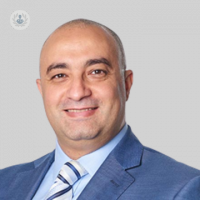Minimally invasive bunion surgery: What are the key benefits for patients?
Autore:In this informative article, we hear an expert insight from revered consultant orthopaedic surgeon Mr Hisham Shalaby on what minimally invasive bunion surgery entails and how the procedure compares to more traditional approaches. In addition, Mr Shalaby also discusses the key benefits of keyhole surgical techniques for bunion corrective surgery and the key factors involved in determining patient suitability for this surgical approach.

What is keyhole bunion surgery? How does it differ from traditional bunion surgery?
In simple terms, bunion describes a deformity of the big toe where it points outward and encroaches on the other toes. However, in reality, bunion is a very complex deformity. It involves axial, coronal and even rotational deformities, and has implications much wider than the aesthetics of the toe. Bunion can impact the weight-bearing distribution across the ball of the foot and also has implications on the alignment of the arch and of the hind foot. As such, bunion is a far more complex problem than just a toe that is deviating outward.
There are many (possibly over 300) different operations described for bunion surgery, but these are all open techniques which utilise different forms of bone cuts to correct the deformity. Keyhole surgery, on the other hand, is a completely new technique that is basically performed through a percutaneous (through the skin) cut of the bone. Through these very small cuts in the skin, we use specific burrs that generate the required cut in the bone which allows us to correct the deformity in all different planes. Following this cut, the bone is fixed with screws which are also placed percutaneously. This creates a stable construct that means the patient is able to mobilise fairly quickly following surgery.
When this minimally invasive technique emerged, the placement of the screws was done under image intensifier guidance. This is still the case but we now have an even better way of doing this, using a highly accurate targeting device that allows the screws to be placed precisely where they should be.
What are the benefits of keyhole bunion surgery compared to other methods?
Compared to the open techniques, keyhole bunion surgery carries a lot of advantages. The most common advantage that patients usually look for is the aesthetics and the fact that the skin cuts are smaller. However, there are far more benefits beyond the aesthetics.
As the cuts are made percutaneously, it means there is less soft tissue trauma and scarring, which in turn translates into less swelling in the postoperative period. Also, another major advantage is that the cuts are made outside of the joint, which means that the joint itself is not disrupted and as a result, there is less stiffness.
In addition, the fixation is very stable, which means we can mobilise patients very quickly and allow them to be fully bearing straight away after surgery. Another technical advantage stems from the burrs that we use, which actually remove a couple of millimetres of bone at the site of the cut. This allows much bigger translations to be undertaken, and essentially means we can correct much more severe deformities.
Lastly, because the cuts used are quite small, this allows us to combine this technique with other procedures. In the past, we would have perhaps had second thoughts about combining bunion surgery with other forefoot or hindfoot reconstructions, because it would have been too many incisions and too much to do surgically. These days, however, as these are minimally invasive approaches causing far reduced trauma to soft tissues, we can now combine bunion surgery with other procedures if needed.
What is the criteria for being a suitable candidate for keyhole bunion surgery?
The key thing is that the patient should be assessed by a foot and ankle consultant who performs these operations on very regular basis. This is very important. During a consultation, the consultant will obtain a thorough history and will do an extensive clinical examination.
There are some red flags that we look for, i.e. things that would make this technique unsuitable for the individual. This could relate to inflammatory conditions, such as rheumatoid arthritis or uncontrolled gout. It’s important that we bear in mind these factors, as these conditions would first need to be managed and could sometimes require a different type of intervention.
In the clinical examination, we also inspect the movement and mobility of the big toe joint. If the joint is quite stiff, for example, that's another red flag which typically means the patient will not be suitable for the technique.
Also, most patients usually present with a clear pattern of pain. Whenever the pain pattern is not typical or the patient presents with vague pains, for example, this should be another red flag because in some cases, the pain could be caused by a different problem in the foot. Even if the patient has a clear bunion deformity, they might be experiencing pain because of problems with their arch, issues in the forefoot, or tightness of their calf muscles, for instance. For this reason, it is very important for the patient to be assessed properly by a specialist with particular expertise.
To learn more about the associated risks and recovery period which follows minimally invasive bunion surgery, read Mr Shalaby’s second expert article on this topic.
If you require bunion surgery and wish to discuss the available treatment options, visit Mr Shalaby's Top Doctors profile to schedule a consultation.


